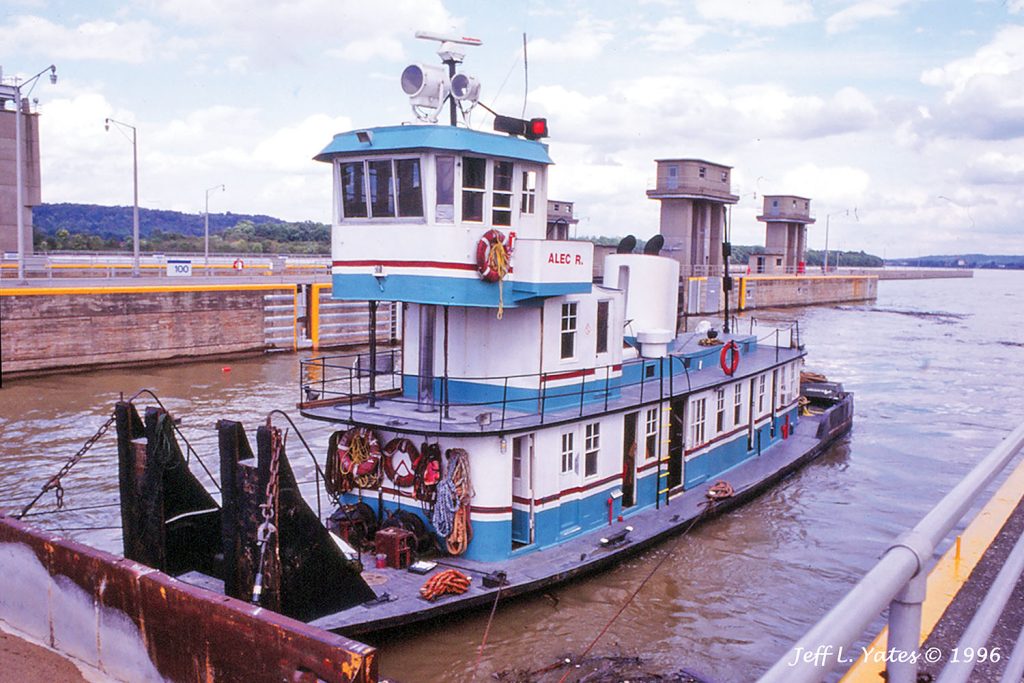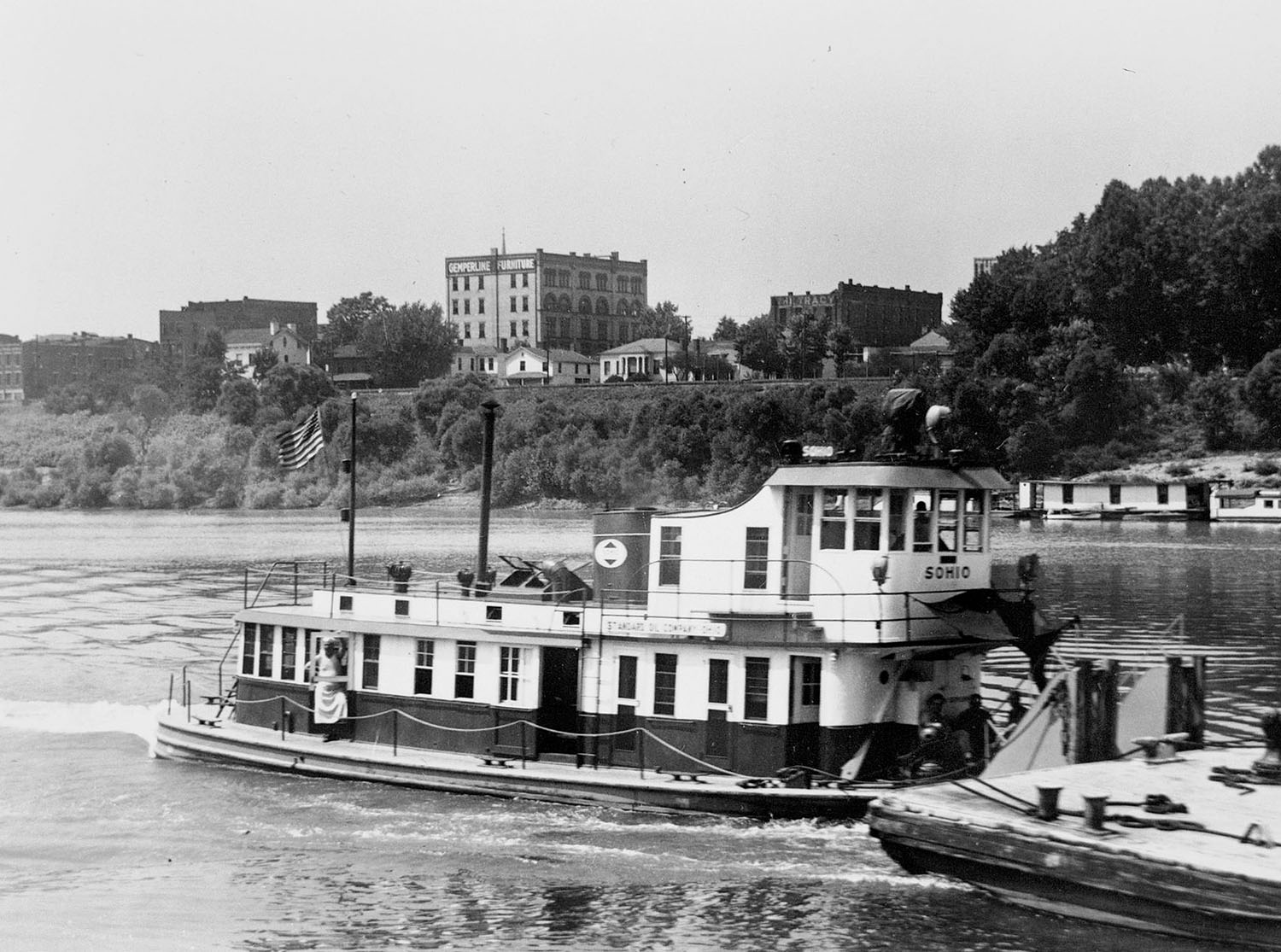In detailing the century-old sternwheeler Standard in the last column, mention was made that it was sold in 1939 after the original owner, Sohio Petroleum Company (Standard Oil), had acquired a new diesel prop towboat. This new boat had been under construction at the Henry C. Grebe & Company shipyard at Chicago when purchased by Sohio. Originally ordered by Hugh C. Blaske of Alton, Ill., it was to carry the name Hugh C. Blaske, but after the sale to Sohio the name was changed to Sohio prior to completion.
Henry Grebe had formed Great Lakes Boat Building in Milwaukee in 1915. In 1921, he relocated to Chicago, formed Henry C. Grebe & Company and married Marguerite (Peggy) Luckett. The Grebe firm became renowned for the yachts they built, as famous for quality as for the customers who purchased them, such as chewing gum manufacturer and baseball executive Philip Wrigley. During World War II, the company built many vessels for the Navy and Coast Guard, including tugs and minesweepers. Henry “Hank” Grebe passed away in 1952, but the business continued under Mrs. Grebe. The last Grebe vessel was built in 1970, but the yard was open as a repair facility until 1994. The Sohio of 1939 was apparently the only river towboat that the company ever built.
The Sohio had a steel hull that was 70 by 18.5 feet and had a 7-foot depth. This hull had a sharply modeled bow and noticeable sheer. The boat was single-screw, powered by a 400 hp. Atlas Imperial diesel that turned the 68-inch propeller. The superstructure was built pool-style, with a full main cabin, a smaller second cabin and a pilothouse on a slight riser forward of the second cabin. Overall, the vessel had a streamlined appearance, with a rounded stern; the cabin and pilothouse corners were also rounded, rather than square. The single smokestack and ventilators sat on top of a skylight that ran the length of the roof, and a SOHIO logo was mounted on each side of the stack. The boat name was on the very stern of the hull, and underneath it was the hailing port, which was, interestingly, Portsmouth, Ohio.
The Sohio entered service in December 1939 and became a faithful workhorse on the Ohio River for the company, towing finished petroleum products from a refinery at Latonia, Ky., on the Licking River opposite Cincinnati to 13 Ohio River terminals between Manchester and East Liverpool, Ohio. The boat carried a crew of 10 accommodated in six bunk rooms.
In 1943, the Sohio was joined by the new 2,415 hp. triple-screw Sohioan, then the most powerful towboat on the Western Rivers. In June 1944, Sohio purchased the 1,300 hp. Edgar C. Johnston, which had been built in 1942, renaming it Sohio Memphis. By 1947, Sohio had acquired three 2,000 hp. DPC steam prop towboats, and the small Sohio was sold to Kosmos Towing Company of Louisville, Ky.
Kosmos Towing Company was owned by the Kosmos Portland Cement Company, which began business in 1904. A cement plant was constructed at a company town dubbed Kosmosdale on the left bank of the Ohio River at Mile 627, and a rock quarry to feed the plant was opened close to another company town called Oolite on the left bank near Richardson’s Landing, about mile 654. Kosmos Cement started building and/or buying their own boats and barges in the early 1920s and began a tradition of giving each towboat a name that began with the letter “K.” Kosmos Towing Company was chartered in 1933, and by the time the Sohio was purchased in 1947, Kosmos also owned the diesel prop boats Killdee, Kings Landing, Knox, Kormorant and Kosmortar.
Kosmos Towing dismantled two sternwheel steam towboats about the time the Sohio joined the fleet. In keeping with tradition, the Sohio was promptly renamed Kestrel. The Kestrel then towed rock and cement for Kosmos and at times performed general towing for other companies. In March 1958, it was sold to Minnesota Harbor Service Company, Stillwater, Minn. At some point after 1965, it was renamed Saturn. In 1970, it was rebuilt, converted to a retractable-pilothouse boat and also converted to twin-screw. Possibly during this conversion, the rounded stern became more square. It was then powered by a pair of GM 8-268A diesels totaling 1,000 hp. In 1986, the boat was again repowered, this time with a pair of Cat D348 diesels and Twin Disc 5.17:1 reduction gears that gave it 1,400 hp.

It was sold in 1989 to River Fleets Inc., St. Paul, Minn., and transferred in 1991 to Walker Boat Yard (division of Midland), Paducah, Ky. In 1995, it was sold to Queen City Riverboats, Inc., Cincinnati, and the following year it was again sold to Kentucky River Towing Inc., Louisville. Kentucky River Towing renamed it first Alec R, and in 1997 named it Timothy G. It towed aggregates from points on the near Ohio River to points on the Kentucky River. This writer would often see it in this trade, and it seemed to perform quite well.
The Timothy G was sold for a final time in December 2004 to Bartley Marine Inc., Wellsburg, W.Va. While it continued to be listed in the Inland River Record through 2006, the 2007 edition carried it in the Off The Record section, showing it as owned by River Salvage Company Inc. and having been dismantled in 2005. The original pilothouse had been used during the conversion to retractable in 1970, and other than the squared-off stern with a bulwark around it, the boat had retained the original appearance dating to 1939 throughout the 66 years it existed.
Caption for top photo: The new Sohio with Portsmouth, Ohio, in the background. (David Smith collection)
Capt. David Smith can be contacted at davidsmith1955obc@gmail.com.




